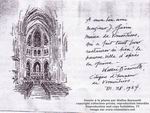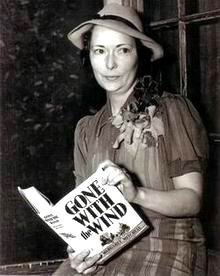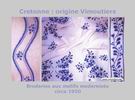|




|
|
 |
|
"Two temporary
barracks square,
made up of Swedish and
American wooden structures,
are built :
◄
one, where the Wheat market building used to stand, the other one on
the east side of the rue du Pont Vautier. In 1945, the Mayor
is Monsieur Gavin and he uses his best endeavours to find financial
assistance. However, some people will be living there for more than
ten years.
|
 |
|

William Welles
Bosworth
1869-1966
|
|

|
|
In 1947,
Welles Bosworth
offers his support, he founds the Committee of American
Aid to Vimoutiers, part of American Aid to France.
This organization aims to collect funds in
order to compensate the overwhelmed State of
France.
Welles Bosworth,
American
neo-classic architect, "in love" with France, regularly
comes to follow the evolution of the
rebuilding. He is Honorary Citizen of
the town of Vimoutiers.
In April 1949,
Vimoutiers is adopted
by the International Pilot-Club thanks to the
intervention of Margaret Mitchell,
contacted by Denis Barois...
But in August
1949, Margaret is struck by a
speeding automobile in a street of Atlanta.
Thus unfortunately she will not be able to
honour with a visit of Vimoutiers her
Honorary citizenship which she had however
accepted on July 27, 1949.
Aids of the Pilot-Clubs of Chicago and
Philadelphia will be substantial and regular.
They will last until circa the 1970' s.
The fountain, built in 1824 on the market place, is rebuilt with the remaining parts after the 1944 bombings and placed in the square of the Pilot Club International.
Five years of help and more :
►
"Pilot international - History"
►
Nowadays, The Pilot club international square in Vimoutiers
Reconstruction - life along the river (named Life) - and "temporary" shops




but what is there in common between "Gone With the Wind" and "Vimoutiers bombings" ... Margaret Mitchell's kindness facing the disaster
Reconstruction - Images d'archives












|

|
|

|
In 1950,
the writer
Marie-Bennett Alsmeyer,
nurse, WWII
US veteran, writes the narrative of her
cycling through Europe, "Six days after
D-Day".
In her
memories, she
devotes
a chapter to her visit of Vimoutiers in
which she expresses her astonishement at the
precariousness of the barracks-like
structures. She publishes in her book
these two photographies (May 1950).
|

|
|

|
1946-1956
:
“Facing the distress of no-income
mothers, the Red Cross
- of which Mrs Boullard,
Dentu, Boittin-
creates a sewing room of
embroidery. The Laniel
Factories
then in difficulty,
make gift of an important
batch of canvas.
Several women bring their
know-how and the embroidery
was born again**…
The
ladies of the Pilot-Club,
charmed by the result,
organize sales each one in
her state.
Thus, large cases - the
linen fabric is heavy and
bulky - leave regularly Le
Havre by boat. In the United
States where all is already
machine-made, the
Vimonasterien hand-made is
successful: orders flow and
points of sale multiply.
**Canvas
and cretonne
|

|
|
The beautiful adventure of the
Norman embroideries in United
States will last for some ten
years,
the time for rebuilding and
return to the normal life "… |
|
|
A few year later,
after 1955,
an interesting aerial view,
the revival of Vimoutiers ...
|
 |
... the rebuilding of the Halle au beurre,
and on the right, a few barracks.
|
|
Sources : Six years after D-Day, Marie Bennett Alsmeyer -
Bulletins n°29 de la Société Historique - le web -
Images : MB Alsmeyer webmaster©wimoutiers.net
- view after 1955 (many thanks to Jean-Pierre)
|